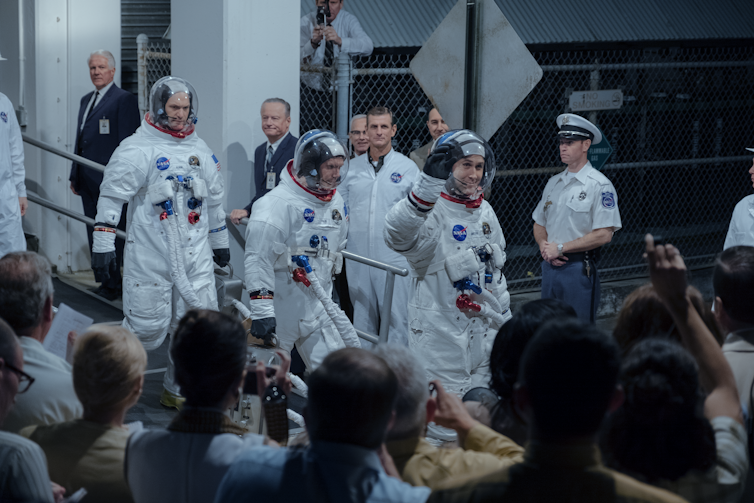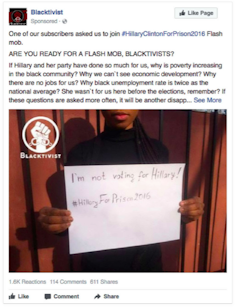 |
| From Universal Pictures Home Entertainment: First Man |
Follow the gripping and captivating true story of the first manned mission to the moon in FIRST MAN, arriving on Digital and via the digital movie app MOVIES ANYWHERE on January 8, 2019 and on 4K Ultra HD, Blu-ray, DVD and On Demand on January 22, 2019 from Universal Pictures Home Entertainment.
Hailed by critics as "the best movie of the year" (Collider) and "exhilarating" (Entertainment Weekly), FIRST MAN comes from acclaimed Oscar-winning director Damien Chazelle (La La Land, Whiplash) and stars Ryan Gosling (La La Land, The Big Short) as Neil Armstrong and Claire Foy ("The Crown," Breathe) as Janet Armstrong in the heroic and emotionally driven journey through a pivotal moment in the history of mankind.
Based on the book First Man: The Life of Neil A. Armstrong by James R. Hansen and from visionary filmmaker Damien Chazelle, FIRST MAN is the riveting story behind the first manned mission to the moon, focusing on Neil Armstrong and the decade leading to the historic Apollo 11 flight.
Receiving two Golden Globe nominations for Best Supporting Actress (Foy) and Best Original Score (Justin Hurwitz), the critically acclaimed film is packed with bonus features including deleted scenes and special featurettes showing behind-the-scenes looks at creating the film.
 |
| The dangers of space were not exaggerated, and started with the terrestrial training. Neil Armstrong (Ryan Gosling) ejected seconds before the Lunar Landing Research Vehicle crashed and burned at Ellington Air Force Base... (Image via LoupDargent.info) |
A visceral and intimate account told from Armstrong's perspective, the film explores the triumphs and the cost—on Armstrong, his family, his colleagues and the nation itself—of one of the most dangerous missions in history.
The critically acclaimed FIRST MAN comes from legendary executive producer Steven Spielberg(Jurassic World: Fallen Kingdom, Schindler's List) alongside fellow executive producers Adam Merims (Baby Driver, Straight Outta Compton) and Josh Singer (The Post, Spotlight) with a screenplay by Singer allowing audiences to relive the historic achievement in human history that has never been told cinematically.
Filled with outstanding performances from an all-star cast led by Gosling and Foy alongside an incredible roster of supporting talent including Kyle Chandler (The Wolf of Wall Street, "Friday Night Lights"), Jason Clarke (Zero Dark Thirty, Mudbound), Corey Stoll ("The Strain," "House of Cards"), Pablo Schreiber (Skyscraper, "Orange is the New Black"), Christopher Abbot ("The Sinner," Whiskey Tango Foxtrot), and Ciarán Hinds ("Game of Thrones," Tinker Tailor Soldier Spy), FIRST MAN "explodes with cinematic wonder" (Inverse).
The Trailer:
4K Ultra HD, Blu-Ray, DVD & Digital Bonus Features:
- Deleted Scenes
- Shooting for the Moon – Take an intimate look at the production of FIRST MAN and the collaborative relationship between Director Damien Chazelle and Ryan Gosling.
- Preparing to Launch – It's difficult to believe that FIRST MAN is the first major feature film to tell the journey of Apollo 11. Hear from Director Damien Chazelle and his cast why now is the time to tell the story of this historic event.
- Giant Leap in One Small Step – A heroic character study, FIRST MAN sheds light on all the hard working individuals that got us to the moon and back.
- Mission Gone Wrong – Watch as Ryan Gosling reenacts a test piloting sequence gone terribly wrong. Go behind the scenes to see how he trained to nail the landing, performing the majority of his own stunts.
- Putting You In the Seat – Through the use of innovative technology, most of FIRST MAN was shot in-camera. Take an in-depth look behind the lens of this epic film.
- Recreating the Moon Landing – Filmed in IMAX to show the vastness of the moon, find out all that it took to recreate the most famous moment in NASA history.
- Shooting at NASA – Hear from Ryan Gosling and Director Damien Chazelle on how shooting at NASA brought unparalleled authenticity to FIRST MAN.
- Astronaut Training – Go behind the scenes of the three day boot camp each of the actors underwent prior to filming FIRST MAN.
- Feature Commentary with Director Damien Chazelle, Screenwriter Josh Singer and Editor Tom Cross
FIRST MAN will be available on 4K Ultra HD in a combo pack which includes 4K Ultra HD Blu-ray, Blu-ray and Digital. The 4K Ultra HD disc will include the same bonus features as the Blu-ray version, all in stunning 4K resolution.
Filmakers:
Cast: Ryan Gosling, Claire Foy, Jason Clarke, Kyle Chandler, Corey Stoll, Christopher Abbot, Ciarán Hinds
Casting By: Francine Maisler CSA Music By: Justin Hurwitz
Costume Design: Mary Zophres
Film Editor: Tom Cross ACE Production Design: Nathan Crowley
Director of Photography: Linus Sandgren FSF Executive Producers: Steven Spielberg, Adam Merims, Josh Singer
Produced By: Wyck Godfrey p.g.a, Marty Bowen p.g.a, Isaac Klausner, Damien Chazelle
Based on the Book By: James R. Hansen
Screenplay By: Josh Singer
Directed By: Damien Chazelle
Technical Information
4K Ultra HD:
Street Date: January 22, 2019
FIRST MAN 4K Ultra HD is available in Dolby Vision. Leveraging the HDR innovation that powers Dolby's most advanced cinemas around the world, Dolby Vision transforms the TV experience in the home by delivering greater brightness and contrast, as well as a fuller palette of rich colors.
Related Stories:
Selection Number: 61201572 (US) / 61201574 (CDN)
Layers: BD-100
Aspect Ratio: Widescreen 16:9 2.40:1
Rating: PG -13 for some thematic content involving peril, and brief strong language
Video: 2160p UHD Dolby Vision/HDR 10
Languages/Subtitles: English SDH, Spanish and French Subtitles
Sound: English Dolby Atmos and Dolby Digital 2.0, French Dolby Digital Plus 7.1, Spanish Dolby Digital Plus 7.1
Run Time: 2 hours 20 minutes
Dolby Vision: Layers: BD-100
Aspect Ratio: Widescreen 16:9 2.40:1
Rating: PG -13 for some thematic content involving peril, and brief strong language
Video: 2160p UHD Dolby Vision/HDR 10
Languages/Subtitles: English SDH, Spanish and French Subtitles
Sound: English Dolby Atmos and Dolby Digital 2.0, French Dolby Digital Plus 7.1, Spanish Dolby Digital Plus 7.1
Run Time: 2 hours 20 minutes
FIRST MAN 4K Ultra HD is available in Dolby Vision. Leveraging the HDR innovation that powers Dolby's most advanced cinemas around the world, Dolby Vision transforms the TV experience in the home by delivering greater brightness and contrast, as well as a fuller palette of rich colors.
Dolby Atmos Soundtrack:
FIRST MAN Blu-ray and 4K Ultra HD will feature a Dolby Atmos soundtrack remixed specifically for the home theater environment to place and move audio anywhere in the room, including overhead. To experience Dolby Atmos at home, a Dolby Atmos enabled AV receiver and additional speakers are required, or a Dolby Atmos enabled sound bar.
FIRST MAN Blu-ray and 4K Ultra HD will feature a Dolby Atmos soundtrack remixed specifically for the home theater environment to place and move audio anywhere in the room, including overhead. To experience Dolby Atmos at home, a Dolby Atmos enabled AV receiver and additional speakers are required, or a Dolby Atmos enabled sound bar.
Technical Information Blu-Ray:
Street Date: January 22, 2019
Selection Number: 61193705 (US) / 61193827 (CDN)
Layers: BD-50
Aspect Ratio: Widescreen 16:9 2.40:1
Rating: PG -13 for some thematic content involving peril, and brief strong language
Languages/Subtitles: English SDH, Spanish and French Subtitles
Sound: English Dolby Atmos and Dolby Digital 2.0, French Dolby Digital Plus 7.1, Spanish Dolby Digital Plus 7.1
Run Time: 2 hours 20 minutes
Street Date: January 22, 2019
Selection Number: 61193705 (US) / 61193827 (CDN)
Layers: BD-50
Aspect Ratio: Widescreen 16:9 2.40:1
Rating: PG -13 for some thematic content involving peril, and brief strong language
Languages/Subtitles: English SDH, Spanish and French Subtitles
Sound: English Dolby Atmos and Dolby Digital 2.0, French Dolby Digital Plus 7.1, Spanish Dolby Digital Plus 7.1
Run Time: 2 hours 20 minutes
Technical Information DVD:
Street Date: January 22, 2019
Selection Number: 61193704 (US) / 61193826 (CDN)
Layers: DVD 9
Aspect Ratio: Anamorphic Widescreen 16:9 2.39:1
Rating: PG -13 for some thematic content involving peril, and brief strong language
Languages/Subtitles: English SDH, Spanish and French Subtitles
Sound: English Dolby Digital 5.1 and Dolby Digital 2.0, French Dolby Digital 5.1, Spanish Dolby Digital 5.1
Run Time: 2 hours 20 minutes
Street Date: January 22, 2019
Selection Number: 61193704 (US) / 61193826 (CDN)
Layers: DVD 9
Aspect Ratio: Anamorphic Widescreen 16:9 2.39:1
Rating: PG -13 for some thematic content involving peril, and brief strong language
Languages/Subtitles: English SDH, Spanish and French Subtitles
Sound: English Dolby Digital 5.1 and Dolby Digital 2.0, French Dolby Digital 5.1, Spanish Dolby Digital 5.1
Run Time: 2 hours 20 minutes
 |
| More than a national effort: (left to right) Buzz Aldrin (Corey Stoll), Mike Collins (Lukas Haas) and Neil Armstrong (Ryan Gosling) head for the Moon. (Daniel McFadden) (Image via LoupDargent.info) |
- First Man: A New Vision Of The Apollo 11 Mission To Set Foot On The Moon
- To Celebrate NASA's 60th Anniversary, Monaco Will Host US Astronauts, Aerospace Experts, and the Screening of "Above and Beyond: NASA's Journey to Tomorrow"
- Museum of Science, Boston Celebrates the Charles Hayden Planetarium's 60th Anniversary with the Release of New Film


























